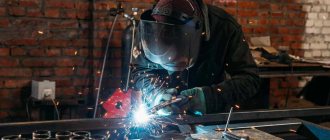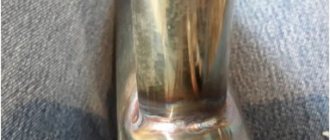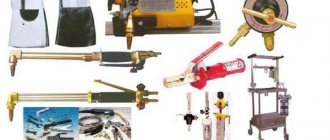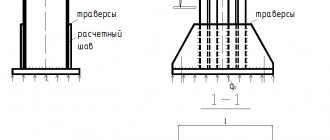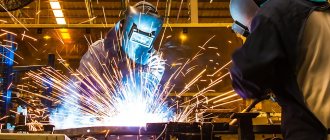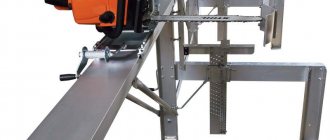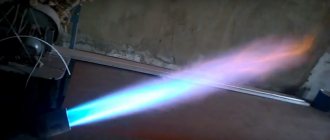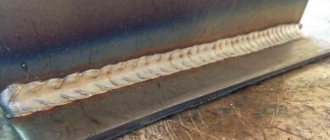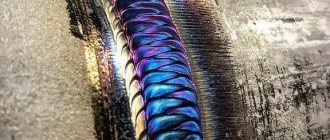Introduction
Currently, one of the pressing problems of mechanical engineering is improving the quality and reliability of structures while simultaneously increasing labor productivity and production automation.
Requirements for improving the quality and reliability of welded structures are met by correctly selecting the type of welding, welding materials, and calculating the most rational welding mode.
Welding is one of the leading technological processes of modern industry, the degree of development and improvement of which largely determines the level of technology in mechanical engineering, construction and a number of other sectors of the economy. A properly developed welding process ensures the production of not only reliable connections and structures that meet all operational requirements, but also allows for the maximum degree of comprehensive mechanization and automation of the entire production process for manufacturing parts, and is cost-effective in terms of energy costs, welding materials and human labor costs. The advantages of welded structures are now generally recognized; such structures are widely used instead of cast and riveted joints. These advantages boil down to reducing metal consumption, reducing labor costs, simplifying equipment, and increasing productivity.
In the designed technological process for the manufacture of box profile beams, special attention is paid to increasing labor productivity, mechanization and automation of welding work through the introduction of new high-performance equipment and the use of new welding materials.
Manufacturing of I-beam metal structures
The process of manufacturing metal beams with an H-shaped (or I-beam) section is quite complicated. To obtain a high-quality design, it is necessary to use proven high-quality raw materials, modern high-tech production mechanisms, as well as the presence of highly qualified personnel. At the same time, high-quality incoming control, comprehensive control of all stages of manufacturing and processing of elements, as well as control of products at the output are required. Only this approach to production can guarantee the highest quality and performance characteristics of the finished product.
Design purpose and requirements for welded joints
A box-section beam is a welded structure of four metal plates welded together to form a closed loop. Such structures are widely used in the construction industry as various types of supports and load-bearing structures. The advantage of using box-shaped beams is that the metal beam works more fully under various kinds of bends (compared to an all-metal beam), while having a relatively small mass.
The beam is made of structural low-alloy steel grade 09G2. The operating conditions of the structure are normal, the operating temperature range is from -30 to +50 degrees.
The design must withstand maximum permissible loads during the design service life, ensure durability and reliability, and provide for the possibility of technical inspection, repair and inspection of the metal in the connection.
The main types, structural elements and dimensions of welded joints performed by submerged arc welding must comply with GOST 8713-79, GOST 11533-75.
The quality of welded structures is determined by:
- rational design;
- quality of the base material; quality of welding materials, flux (compliance with certificate, state standard or technical specifications);
- quality of part assembly;
- quality of surface preparation of parts for welding;
- the level of the developed technological process, the degree of automation of assembly and welding operations;
- qualifications of welders, operators and adjusters, general production culture;
- weld quality: i.e. made without defects, in accordance with the requirement of strength, smooth transitions to the base material.
Incoming parts for welding must meet the requirements of the drawing. The welded edges of the parts in the places where the seams are applied and the adjacent edges with a width of at least 20 mm in each direction must be cleaned of scale, rust, paint, lubricant oil and other contaminants to a metallic shine. Control of stripping dimensions is carried out using a metal measuring ruler or a caliper.
Parts prepared for welding should not have sharp edges. After stamping, parts intended for welding must be cleaned of oil, grease, and dirt using washing solutions.
Manufacturability is understood as design optimal forms that meet the service purpose of the product, ensure operation within a given resource, and allow the product to be manufactured with minimal costs of material, labor, and time.
A design can be considered technologically advanced when:
- The material has good weldability, is not prone to the formation of cold and hot cracks, embrittlement, is not sensitive to the formation of hardened structures, has a low tendency to red brittleness, cold brittleness, is heat-resistant, and corrosion-resistant.
- The design of the product allows the use of mechanization and automation of assembly, welding and transport operations.
- The design can provide free access of electrodes to the welding site. those. connection type - open.
Based on the above, we conclude that the design is technologically advanced.
Base metal weldability assessment
Technological weldability is understood as the ability of a material to form a strong connection during a rational welding process without significantly reducing the technological properties of the material being welded in the connection itself and in the adjacent area.
Mandatory criteria when assessing weldability are the resistance of the welded joint against the formation of hot and cold cracks, as well as the equivalence of the mechanical properties of the welded joint to the base metal.
For carbon and low-alloy steels, the resistance of a welded joint against the formation of hot and cold cracks is assessed indirectly by carbon equivalent.
- Evaluation of the resistance of carbon steels against the formation of hot cracks based on carbon equivalent
Steel is not prone to hot cracks.
- Evaluation of the resistance of carbon steels against the formation of cold cracks based on carbon equivalent
Steel is not prone to cold cracks.
Application area
Prefabricated buildings and structures are created with supporting and load-bearing metal frames; floors and trusses are made from them. When using welded I-beams, the weight of buildings is reduced and they do not require a powerful foundation.
The welded I-beam is characterized by high strength, durability, and is not subject to fatigue failure. It is used in heavy engineering; it is used to make elements that experience high pressure and are subject to rupture.
Unlike I-beam wire rods, welded wire rods are not limited in size. By welding strips, beams of any section and length are obtained. Architects are not limited in their flights of fancy.
The manufacturing process for I-sections produces little waste. They can be made with shelves and walls made of different grades of steel: in places of minimal stress, carbon steel or perforated steel sheets are used, loaded parts are made of alloy rolled steel.
Selecting the type of welding
We select the welding technology based on the following requirements:
- Equal strength of the weld metal with the base metal;
- No cracks, lack of penetration, pores, undercuts, slag inclusions;
- The welded joint must be resistant to becoming brittle;
- Changes in shapes and sizes (deformations) must be within reasonable limits that do not affect the performance of the structure;
Let's consider three welding methods for a given steel:
- Manual arc welding with coated electrodes;
- Welding in a shielded gas environment with a consumable electrode;
- Automatic submerged arc welding;
Possible defects
During welding of an I-beam, due to non-compliance with the technology, crystallization of the steel occurs due to high temperature. Due to phase discrepancies, internal stresses arise in the metal. Strength and rigidity decrease, and the risk of corrosion increases.
When welding steel sheets, other defects are possible:
- violation of the shape of the seam; deviation from the shape of the outer surfaces or the geometry of the joint;
- burns, when the melt flows out of the bath, holes form in the seam;
- undercuts – grooves along the joint boundary;
- cracks forming in places where the seam breaks;
- slag or tungsten inclusions in the diffusion layer; at high welding speeds, refractory oxides are formed.
Metal products with defects are unreliable; they will not withstand heavy bending or torsion loads. They are discarded and boiled again if possible.
Manual arc welding with coated electrodes
Currently, it remains one of the most common methods used in the manufacture of welded structures. This is explained by the simplicity and mobility of the equipment used, the ability to perform welding in various spatial positions and in places that are difficult to access by mechanized welding methods. A significant disadvantage of manual arc welding with coated metal electrodes is the low productivity of the process and the dependence of the quality of the weld on the practical skills of the welder.
It should also be noted that the limited welding current during manual welding leads to a smaller penetration depth, which in turn necessitates the use of edge grooves, and a low deposition rate leads to an increase in the number of passes to fill the groove. All this ultimately leads to a decrease in work productivity and deterioration in the quality of the welded joint. In addition, the need to periodically break the arc to change the electrode also disrupts the uniformity of the seam along its length and worsens the overall mechanical properties of the joint.
Thus, the advantages of manual arc welding:
- simplicity and mobility of the welding method;
- availability of a wide range of electrodes;
- low cost of welding.
Flaws:
- low welding productivity (3 kg/hour);
- low quality of weld metal;
- unsightly appearance of the seam;
- presence of splashing.
Production technology of welded I-beams
Small batches are made using electric arc or argon welding, depending on the grade of metal and its ability to be welded.
To produce welded beams industrially, special welding lines are used. Fluxes are used to protect the melt pool from oxidation.
Welding a beam in automatic mode is similar to manually making an I-beam. Main technological stages:
- cutting rolled sheets into strips of the required width using a thermal cutting machine with program control, average cutting speed 1 m/min.
- end milling on end milling machines reduces the joint gap between the wall and the shelf and improves the quality of welding;
- the process of assembling an I-beam is carried out at high speed on a special machine; metal strips are fixed by clamping devices with hydraulic amplifiers; first a T-shaped joint is made, then the second wall is added; this design is convenient to weld;
- welding work is carried out using portal-type machines of two types: a) two seams are shallowly welded at once using inclined electrodes; b) the boat seam is created in stages: first on one side of the I-beam, then on the other; the metal is boiled to a great depth;
- the final stage is straightening the I-beam on special rollers; minor distortions that arose during assembly and welding of the profile are eliminated.
